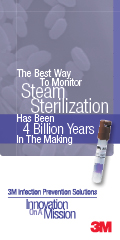
| Past Issues | Advertise | www.csao.net | January 20, 2012 |
Performing Reprocessing of Reusable Medical Devices Safely - By Colleen Landers, Registered Nurse and Medical Device Reprocessing Technician
By: Colleen Landers, Registered Nurse and Medical Device Reprocessing Technician
This article is written to provide one with options if the reprocessing of reusable medical devices cannot be performed effectively and safely. As one may be aware, the reprocessing of reusable medical devices is complex. It requires a quality system and, if not performed to Canadian Standards, can place citizens at risk of obtaining disease or infection. Over the past five years, this issue has been publicized through Canadian media highlighting the fact that thousands of Canadians are being put at risk due to the lack of robust reprocessing practices, with many acquiring diseases including HIV and Hepatitis. This is a direct result of health care facilities, doctor’s offices, and clinics not having quality reprocessing systems for reusable medical devices. Every citizen deserves to receive the highest level of quality of care and similar quality with regard to the reprocessed instruments being used during procedures. Facilities that perform invasive procedures with reusable medical devices need to ensure that the reprocessing practices meet the Canadian Standards for Reprocessing. There are mandatory procedures and regulations written in the Canadian Standards (CSA) and Ministry of Ontario Health and Long Term Care Provincial Infections Disease Advisory Committee (PIDAC) Best Practices documents that work to prevent the infection of patients during procedures. These are not just guidelines or recommendations but are mandatory and expected by the Canadian public. In order to meet best practices for reprocessing reusable medical devices, staff must be certified, and trained and must also receive ongoing education. Due to the complex nature of the reprocessing, certified Medical Device Reprocessing Technicians are required to perform such tasks. Monitoring of the process is essential in ensuring the sterility and disinfection of the equipment. Sterilization equipment needs to receive preventative maintenance and regular cleaning which must be documented through printouts to ensure the temperature and parameters have been met for sterilization or disinfection. In addition, packaging must meet all requirements. In addition to being aware of who may be reprocessing instruments, one must also be aware of where this reprocessing is taking place. Reprocessing (cleaning, wrapping, and sterilization) cannot be performed in one room. The environment where decontamination, packaging, sterilization and storage occur must meet CSA Z314.3 and CSA Z314.8 and PIDAC requirements. For example, a proper one-way flow within the department is required to prevent cross-contamination. Through compliance with these requirements, a quality system is created. Without robust adherence, the reprocessing procedure is compromised, and therefore places patients at risk. The above requirements cost money to acquire and maintain. In order to reprocess instruments safely and effectively to avoid patient risk, a facility must examine if there are any gaps between the standards and its current reprocessing practices. If gaps are found, the facility must find the funding to implement best practices that meet the standards and ensure patient safety. If these resources are not available, the facility needs to consider if they should continue reprocessing, and must evaluate alternatives such as sterile single use medical devices or off site reprocessing. This is where facility management must perform a risk assessment and cost analysis. The first question that needs to be asked is "Are we performing surgery and endoscopy procedures?" If yes, then the risk analysis must be performed according to CSA standards. If a healthcare facility, clinic, physician’s office, dental office, or any other location is performing any other types of procedures that invade the blood stream, then they too must examine their processes according to CSA reprocessing standards. Some key elements of risk assessment would be equipment maintenance and age, quality of product produced, staff education and competency, monitoring of decontamination, disinfection and sterilization. The information above sets the stage for the remainder of this article which is a case study from Northern Ontario. The following reprocessing solution outlined below should be explored by facilities that currently do not perform comprehensive and leading practice reprocessing procedures for operative and endoscopy procedures.
In the remote, fly-in communities of Ontario, reprocessing of reusable medical devices had been performed for a number of years using table top sterilizers operated by Registered Nurses trained in reprocessing. The facility staff attended M DRD Technician courses for training sessions. During these sessions, participants were provided with education, audits of practices, and expertise on writing policies and procedures to ensure the facility procedures met CSA standards. Bi-annual site visits found sterilizer monitoring and maintenance was performed, but not by qualified staff, and not to the level required by CSA standards. This was largely due to the facilities’ remote location and cost implications. Monitoring of loads with biological and chemical indicators was found to be inconsistent and did not meet CSA standards. The gap in proper procedures was largely due to high staff turnover, nursing duties that did not allow time for reprocessing, and a lack of education. Through examination of the facilities’ current procedures, it was found that the methods being used within these rural areas over the past fifteen years could not meet the required regulations. With the gaps in the current system identified, with the help of staff and physicians, a medical device needs assessment form was completed for each of the three current site locations, with two additional locations to follow. Once the list of required medical devices for the procedural mix was prepared, a review of the available in-stock single-use disposable devices at each healthcare facility was completed. This review included required tray compilation as well as content review with a nurse representative and physician at each site. Throughout this transition process there were many teleconference meetings with users, management, and infection prevention and control. Once the list was adjusted, and a small but sufficient percentage of devices in-stock were found, a request for proposal was sent out to four companies selling single-use medical devices in single sterile packs and trays. The proposals were reviewed and two companies were eliminated as they either had limited product offerings or offerings that were too costly for the facilities. Sampling of the two competing product offerings then took place to ensure that the product quality met user demands and that the staff, using the devices, could safely perform procedures on patients. The infection control practitioner was involved throughout the process as well as the MDRD reprocessing manager at the hospital site. In addition, each of the three sites was visited by a team consisting of an MDRD manager, a material manager, an infection control representative, and a reprocessing consultant to examine the reprocessing procedures at each site. These inspections included ensuring there was a central room for storage present as well as face-to-face discussions with directors at the individual clinic sites. There were five trays that were unavailable in the single-use sterile format. In order to make these readily available to the facilities, custom trays were developed with high quality stainless steel instruments, and products as requested by the doctors and nurses. These trays were sampled, and after examination of the products and a few adjustments made, both user groups were very satisfied with the end product. Both nurses and doctors were very satisfied with the quality of the instruments and even commented on the fact that they have more variety and better quality with single products due to poor care of reusable instruments. Foot care instruments were a challenge but, a solution was found through a company based in London, Ontario that provided a great quality, single-use foot care kits for a reasonable price of $7.50 per kit. The cost of reprocessing the equivalent reusable medical devices, including factoring in a percentage cost of reusable product, staff time, packaging, monitoring, and sterilization was $8.00. These figures demonstrate the payoff of performing a cost analysis in order to choose the best solution for patient care and value. The list of single-use items included in this case study included the following:
There was already stock of sterile catheters, suctions, gauze, telfa and abdominal dressings, cotton balls, q-tips, and tongue depressors. With all of the research completed, there were three items that were unavailable in single sterile format; Simpson delivery forceps, McGill’s intubation forceps, and ring cutter. Double stock of these reusable items was purchased for each site to ensure availability when one set was being sent for reprocessing. Another area considered was the process for transporting devices from central processing to the various sites. Research on the CSA transport and Health Canada standards was performed to ensure the process would meet all requirements in the policy. Policy and procedure guidelines were developed to enable safe transport of these items to the central medical device reprocessing department at the hospital site. This department had been built to meet CSA specifications three years prior and was staffed by qualified reprocessing technicians under a qualified manager. Transport containers were examined in order to meet the standards and be safe for air transport to the central processing site. These containers were then purchased with backups for each site to ensure availability at all times. Tamper-proof devices were also purchased to help identify if containers had been opened during transport further ensuring sterilization and safety. With the stainless steel wire rack shelving purchased, the inventory of all items in the central stores obtained, the room was prepared for sterile central storage. Stock was bulk shipped, based on the quotas decided by the team, by cargo plane to each site and dropped shipped into the facilities. The central store room within these facilities contained the four wire racks needed to set up sterile storage. During the week-long visit, each site was set up identically with stock quotas, labels were provided, shelves and carts were numbered, and inventory stock lists and order sheets were compiled. Product in-servicing and training on ordering and policy procedures for all of the registered nurse staff and directors occurred in the afternoons, the evening, and at night so as not to interrupt patient care. At each site, the sterilization supplies, sterilizers, and all reusable medical devices were packed up and shipped back to the hospital reprocessing centre where they would be sterilized and kept within the facility for future use. All sterilization supplies were removed from the stock room and order sheets and locations were supplied with new inventory lists. The facility staff was happy with the transition as they were not certified or trained to reprocess medical devices and therefore did not feel comfortable doing so. With the stresses of having to perform such tasks alleviated, the nursing staff was now able to more fully focus on patient care. They also felt that they had more product choice and that the quality of these products was higher, therefore reducing patient risk. Physicians found that the products met their needs, were of good quality, and were available when required. This was a benefit as many times reusable devices were previously unavailable as they had not been reprocessed. One concern that arose during the project was the possible negative effect that single-use disposable medical devices may pose on the environment. While this concern was researched, the waste management company which provided services to the sites was contacted to explore possibilities to reuse the instruments. Hospitals in other geographies often arrange for the instruments to be placed in bio-hazardous pails, shipped, decontaminated, packaged and sterilized for reuse in 3rd world countries. Although this option was not viable for this region, another solution was created in partnership with the waste management company. The disposable medical devices would be collected in red bio-hazardous containers, shipped along with regular bio-hazardous wastes to the land-fill sites, at which time the devices would be decontaminated and melted in order to make the steel reusable. In this way the land-fill would not be affected. This appeased the local communities as they were concerned about the negative effects this may pose. This case study demonstrates that while every facility may not be able to meet CSA reprocessing standards for reusable medical devices, there are alternatives available. Not meeting CSA reprocessing standards, and Ministry of Health and Long Term Care PIDAC Best Practices for Cleaning, Disinfection, and Sterilization is not acceptable as it places patients at risk of obtaining disease or infection. A solution must be found. Patients put their health and safety into the healthcare facilities’ and healthcare workers’ hands and do not expect to experience adverse effects due to improper processing procedures. It is crucial to either meet CSA standards for reprocessing reusable medical devices or find a safe solution so that we are reducing risk of infection, and that Canadian citizens are receiving quality care.
|
Box 225 / Timmins, ON / P4N 7CP
Phone: 705.268.4763
Fax: 705.268.4421




